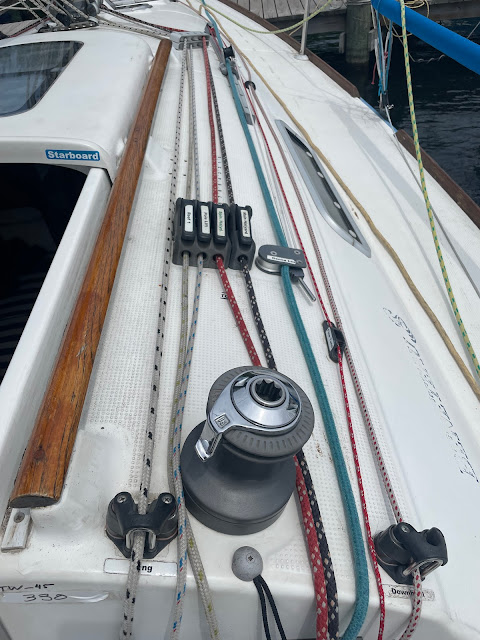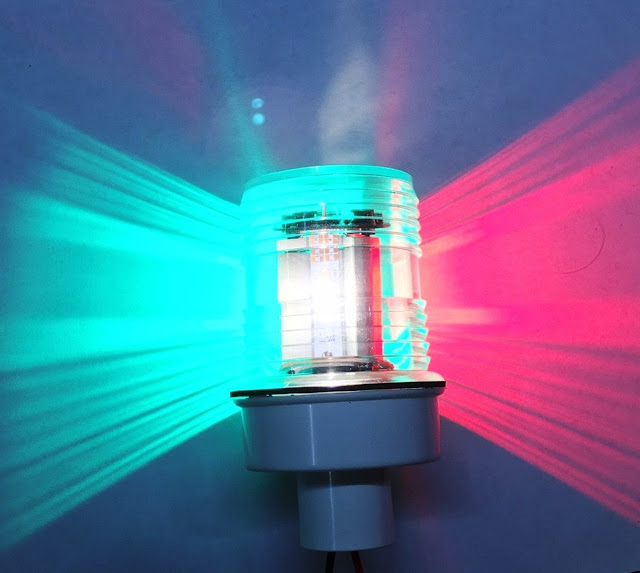Pit/control line optimzation
As we race a lot of windward/leeward races, the efficiency of the pit is of primary importance. While generally well thought out in the original design and hardware assortment, there was a number of things I wanted to do to make it better. And as we often sail with asyms, it needs to support that as well. Some of the goals were:
Double end key controls (vang, foreguy) so they can be played from either side
Increase the purchase for key controls (vang, foreguy, outhaul, cunningham)
Run halyards for optimal port windward roundings
Create the same pit environment as the First 36.7 (cross-training boat)
Bring the cunningham into the pit
Double ending the vang and pole down means 4 and not 2 line controllers, as well as deck turns. This means 2 extra clutches and deck organizers, as well as moving the furling line.
The starboard side looks like this; from the inside out:
Vang
Reef
Spinnaker topping lift
Main Halyard
Spin Halyard
Genoa sheet
Genoa car adjuster
Spinnaker foreguy
Genoa car adjuster
Spinnaker foreguy
Double end key controls (vang, foreguy) so they can be played from either side
Increase the purchase for key controls (vang, foreguy, outhaul, cunningham)
Run halyards for optimal port windward roundings
Create the same pit environment as the First 36.7 (cross-training boat)
Bring the cunningham into the pit
Double ending the vang and pole down means 4 and not 2 line controllers, as well as deck turns. This means 2 extra clutches and deck organizers, as well as moving the furling line.
The starboard side looks like this; from the inside out:
Vang
Reef
Spinnaker topping lift
Main Halyard
Spin Halyard
Genoa sheet
Genoa car adjuster
Spinnaker foreguy
On Port (inside out):
Vang
Main Outhaul
Cunningham
Genoa Halyard
Asym Tack Line
Genoa sheetGenoa car adjuster
Spinnaker foreguy
Harder to see but the jib cars have a length of shock cord running from the front of the track to the line lock and back up to the car, helping the car come back with the line is released. Also our tack line is VERY long, allowing us if need be to blow it and pull the asym all the way back into the companionway without having to undo the shackle.
The foreguy is now naturally 2:1 with its up-down at the bow. The cunningham and outhaul are as well, with the control line running through the eye and back to a hard point. The vang is now a very powerful 12:1 and requires some special work, as shown in the picture below.
A SS mast base plate is mounted aft of the mast through the deck. A dyneema strop splits the load between the mast base and the plate, and creates an extra 2x for the 6:1 double ended vang, giving the final 12:1.
The stacked deck organizers (available from Beneteau) are shown as well. The the vang plate is sourced from Garhauer Marine at this link.
The halyards are New England Rope VPC, the genoa sheets are NER T-900. All other lines are NER Stayset.
The furling line runs down the port side to the stern pulpit, where it is furled by the driver. The block and cleat here not only allows us to secure the line, but by doing so and then pulling hard on the sheets, the furled sail acts like a 'fractlator', pulling the past tip forward when under spinnaker.
The crew is very happy with the layout, and as many also crew on the 36.7 it makes for easy cross training as the 367 looks like this from the factory. Its a great setup.






Hi,
ReplyDeleteI would like to ask how your spipole topping lift line is routed? Through the mast as halyard lines or does it go outside the mast to the block above the spreaders?
Just ordered a new spinnaker and found out that there is no hole out from the mast for spipole topping line....
-Pertti Koskinen-
Thru the mast. The exit is about 60cm above the spreaders. The entry is on starboard, lower than the halyards. Strange there was no exit!
ReplyDelete